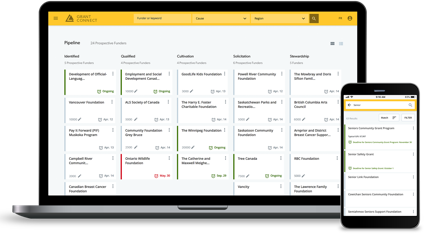This article was originally posted on October 11, 2011. Last updated on May 6, 2021.
So your nonprofit organization has an exciting initiative but you need support to get it off the ground? Wondering how to build a list of prospective funders? We explored this question with the help of Marcia Steeves, a prospect research professional with nearly a decade of experience in the field. Marcia is the Annual Giving and Stewardship Officer at Fleming College, and the Vice President Secretary for the Association of Professional Researchers for Advancement (APRA) Canada.
What makes a good prospect?
Generally, a good prospect has an interest in the work of your organization, the capacity to provide you with the support you need, and ideally has a direct connection or linkage to your organization.
Connection
Marcia uses lists of previous funders during her prospect research, as a positive funding experience in the past can greatly improve the chance of being supported by that funder in the present. An “inside connection” can be equally valuable. Speak with past and present staff, board members and volunteers. Open yourself up to a much broader network of affiliates, and you may be surprised to discover an ally in these contacts who will play an central role in your “ask”.
Remember to document all your connections! Marcia noted the value of thoroughly and accurately tracking all prospect information, “I think that’s my best lesson learned: how important that little information can be.” Ensure your staff is encouraged to note and follow-up on these connections. A lack of tracking can lead to lost funding opportunities.
Interest
Look to online resources, like Grant Connect, to grow your list. Initially structure your search around geographic criteria as well as funding interests. As you evaluate prospects, ask yourself these questions to uncover additional links between funder interests and your particular funding need.
Geographic region: Is the funder open to supporting projects nationally or locally? If they prefer to fund locally, does the funder have an expressed interest in supporting the communities you work with? If looking at corporate funders, does their business have operations in your vicinity?
Priorities: Based on the funder’s purpose or mission statement, what population and/or issue are they interested in funding and can this be linked to your work? Who have they given to in the past? Have they funded organizations like yours or ones that you have a relationship or partnership with? If it is an institutional funder, like a large foundation or corporation, do they have various programs or funding streams?
Support preferences: Is the funder interested in providing the kind of support you need? Will they fund ongoing program costs or do they prefer to fund time-limited projects?
These questions will do more than build your prospect list. By tracking these details, you will be ready to compare these criteria when deciding who is best to approach, and be ready to build a targeted case for support. Track this information and its sources in either print or electronic format. Although access to a prospect management database may help, you can be equally successful using spreadsheets or developing your own system. Professionals like Marcia find success tracking much of their information in good old excel spreadsheets.
Capability
As you build your list of prospects, determine the capacity of each funder. How large are their grants? How large is their asset base? If the information is available, make note of the number of organizations they support. The knowledge that a funder gives a hundred grants, versus five, will be helpful in determining the likelihood of receiving support.
Remember that these questions also apply to large institutional funders, such as corporations and major foundations. Keep in mind that large funders receive thousands of requests each year. To efficiently handle the sum of requests they receive, these funders usually develop policies for giving, including the maximum size of donations.
Qualifying your Prospects
Before you decide which funders to solicit, you’ll want to apply the connection, interest, and capability criteria much more rigorously to your list of prospects. This is often referred to as qualifying prospects. Many fundraisers use LAI (Linkage, Ability, Interest) to evaluate prospects. Medium has a great article on how to use LAI to find the best prospects.
Marcia and her team hold meetings to work through the broader list of prospects and assign them to lists A, B, or C based on relevance and appropriateness to the current funding project. She explained that prospects on list A typically include those where a personal connection exists coupled with strong evidence for capability and interest. Alternatively, prospects are moved to list C if they will not fulfill the current funding need, but are worth tracking for future projects.
Develop a ratio rule to focus your research efforts. We heard from Marcia that during capital campaigns her aim was to have three qualified prospects for every donation the team was hoping to receive. Similarly, if your hope is to secure three grants of $10,000, aim to qualify nine prospects with the capacity to give gifts of that size. Marcia’s advice is to adjust the prospect-to-gift ratio depending on the size of gift you are seeking, so the larger the gift, the greater the number of prospects you will require.
The Grantseeking Cycle
Remember that your work isn’t done once you’ve qualified your prospects. “Good prospect research helps in every part of the donor pyramid,” says Marcia, from identifying and evaluating a pool of potential funders to gathering detailed information for the subsequent solicitation and stewardship phases of the grant cultivation cycle.



